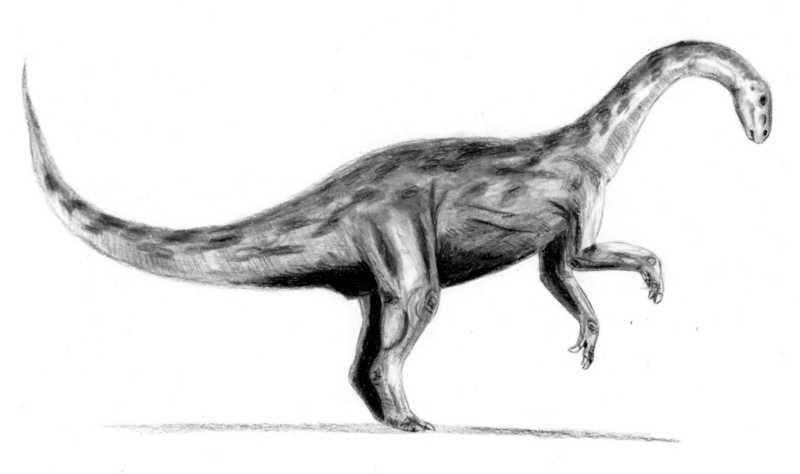- Prosauropoda
Taxobox
name = Prosauropods
fossil_range =Late Triassic -Early Jurassic

image_width = 250px
image_caption = "Yunnanosaurus huangi"
regnum =Animal ia
phylum = Chordata
classis = Sauropsida
superordo =Dinosaur ia
ordo =Saurischia
subordo =Sauropodomorpha
infraordo = Prosauropoda
infraordo_authority = von Huene, 1920
subdivision_ranks = Families
subdivision = See textProsauropoda (pronEng|ˌproʊsɔˈrɒpədə) or prosauropods (IPA|/proʊˈsɔroʊpɒd/) were a group of early
herbivorous dinosaur s that lived during theTriassic and earlyJurassic periods. They were frequently the predominant herbivore in their environment, and quickly reached large size (6 to 10 meters long [20 to 33 ft] ). All prosauropods had a long neck and small head, forelimbs shorter than the hindlimbs, and a very large thumb claw (inherited from thethecodontosaur s) for defense. Most were semi-bipedal, although at least one large form ("Riojasaurus ") was fully quadrupedal. They were originally thought to be the ancestors of thesauropod s, but are now considered a parallel lineage.Changing definitions
The Prosauropoda were originally defined as the early, bipedal,
Triassic ancestors of the greatsauropod dinosaurs. More recently, cladistic analysis suggests that rather than being ancestral to sauropods, prosauropods were a sisterclade . Recent studies of the genus "Massospondylus " reveal that the Prosauropoda is indeedmonophyletic .The problem however lies in what genera are considered prosauropods. Upchurch (1997) proposes a Node-Based Definition: Blikanasauridae, Thecodontosauridae, Anchisauridae, Plateosauridae, Melanorosauridae, and all
sauropodomorph s closer to them than sauropods. More recently, on the basis of studies of early sauropodomorphsAdam Yates proposed a cladogram in which the primitive genera "Saturnalia", "Thecodontosaurus ", and "Efraasia " (basically, aparaphyletic Thecodontosauridae ) represent basaloutgroup s prior to the prosauropod-sauropod split. "Anchisaurus " (despite its classic "prosauropod" build) is now recognised as the most primitive sauropod (Yates 2004). The melanorosaurs and blikanasaurs are very early members of the sauropod line.Technical diagnosis
The Prosauropod
skull was approximately half the length of thefemur ; theirjaw articulation was slightly below the level of themaxilla rytooth row. Their teeth were small, homodont or weakly homodont, spatulate, with coarse marginal serrations; manualdigit I bore a twisted first phalanx and an enormous, trenchant ungual medially directed when hyperextended. Prosauropod digits II and III were of subequal length, with small, slightly recurved ungual phalanges; digits IV and V were reduced, and lacked ungual phalanges. Typical Prosauropod phalangeal formula was 2–3–4–3. The blade-like distal parts of the pubis formed a broad, flat apron. The fifth pedal digit was vestigial; the femur had a longitudinal crest proximal to the lateral condyle. The lessertrochanter was a weak ripple proximodistally lying on the latero-anterior surface, and the main parts of the trochanter were below the level of the femoral head (Gauffre, 1993).History and general description
Sauropodomorphs first appeared on the
supercontinent ofPangaea as small (1.5 to 3 meters long [5 to 10 ft] ) forms during the middle or late Carnian age (the earliest part of the lateTriassic ). They are known fromBrazil ("Saturnalia" and "Unaysaurus "),Madagascar (recently discovered), andMorocco ("Azendohsaurus").Prosauropods retained the same body plan, but by the later Early or Early Middle Norian age had doubled in linear dimensions, as indicated by the 4 to 6 meter long (13 to 20 ft) "Plateosaurus gracilis" of the Lower and Middle
Stubensandstein ofGermany . This animal in turn gave rise to other species of "Plateosaurus ", and this animal — 8 meters long (26 ft) and around 1,500 kg or more in weight — dominated the Late Norian environment, persisting into the Rhaetian age. Meanwhile in Argentina an even larger prosauropod, "Riojasaurus ", served a similar role This animal, 10 meters long (33 ft), was so big it had to walk on all fours. Curiously, in southernAfrica at this time the megaherbivore niche was taken not by prosauropods but by basal sauropods, as indicated by "Euskelosaurus ", "Melanorosaurus " and "Blikanasaurus", and "Antetonitrus ". Interestingly, while sauropodomorphs dominated the Norian and Rhaetian large herbivore niche, the large carnivore niche continued to be ruled by theCrurotarsi (e.g. ornithosuchids and 'rauisuchians').The end-Triassic extinction killed off the basal sauropodomorphs like "Thecodontosaurus", "Riojasaurus" and species more closely related to sauropods such as "Melanorosaurs" and "Blikanasaurus". However, 'prosauropod' species such as "Anchisaurus" survived, as did true sauropods. While the first sauropods diversified, the early
Jurassic prosauropods radiated out in a number of medium sized (4 to 6 meter long [13 to 20 ft] ) megaherbivores like "Massospondylus ", "Lufengosaurus " and "Yunnanosaurus " and were as successful as their late Triassic predecessors.The prosauropod reign came to an end in the late Early Jurassic. Both prosauropods and anchisaurs died out at the same time, while the basal sauropods survived and continued to radiate.
Classification
After Yates (2003) and Galton (2001) [http://dml.cmnh.org/2003Jul/msg00103.html] .
*Suborder
Sauropodomorpha
** ?"Azendohsaurus "
** "Saturnalia"
** "Thecodontosaurus "
** "Efraasia "
** Infraorder PROSAUROPODA
*** ?"Yimenosaurus "
*** ?"Mussaurus "
*** FamilyRiojasauridae
**** "Eucnemesaurus "
**** "Riojasaurus "
*** Plateosauria
**** FamilyPlateosauridae
***** "Plateosaurus "
***** "Sellosaurus "
***** "Unaysaurus "?
**** FamilyMassospondylidae
***** "Coloradisaurus "
***** "Lufengosaurus "
***** "Massospondylus "
***** "Yunnanosaurus "
***** "Jingshanosaurus "References
* Gauffre F.-X. (1993): The Prosauropod Dinosaur Azendohsaurus laaroussii from the Upper Triassic of Morocco. Palaeontology 36(4): 897–908.
* Upchurch, P (1998), The phylogenetic relationships of sauropod dinosaurs. Zool. J. Linnean Soc. 124: 43–103.
* Yates, A. M. (2004) Anchisaurus polyzelus (Hitchcock): the smallest known sauropod dinosaur and the evolution of gigantism among sauropodomorph dinosaurs: Postilla, n. 230, 58 pp.
* Yates, A.M. & Kitching, J. W. (2003) The earliest known sauropod dinosaur and the first steps towards sauropod locomotion. Proc. R. Soc. Lond.: B Biol Sci. 2003 Aug 22; 270(1525): 1753–8.
External links
* [http://www.palaeos.com/Vertebrates/Units/Unit330/330.100.html Prosauropoda] . "Palaeos".
* [http://dml.cmnh.org/2003Jul/msg00103.html Sauropodomorph phylogeny] . (2003) Mickey Mortimer. "Dinosaur Mailing List Archives".
Wikimedia Foundation. 2010.
